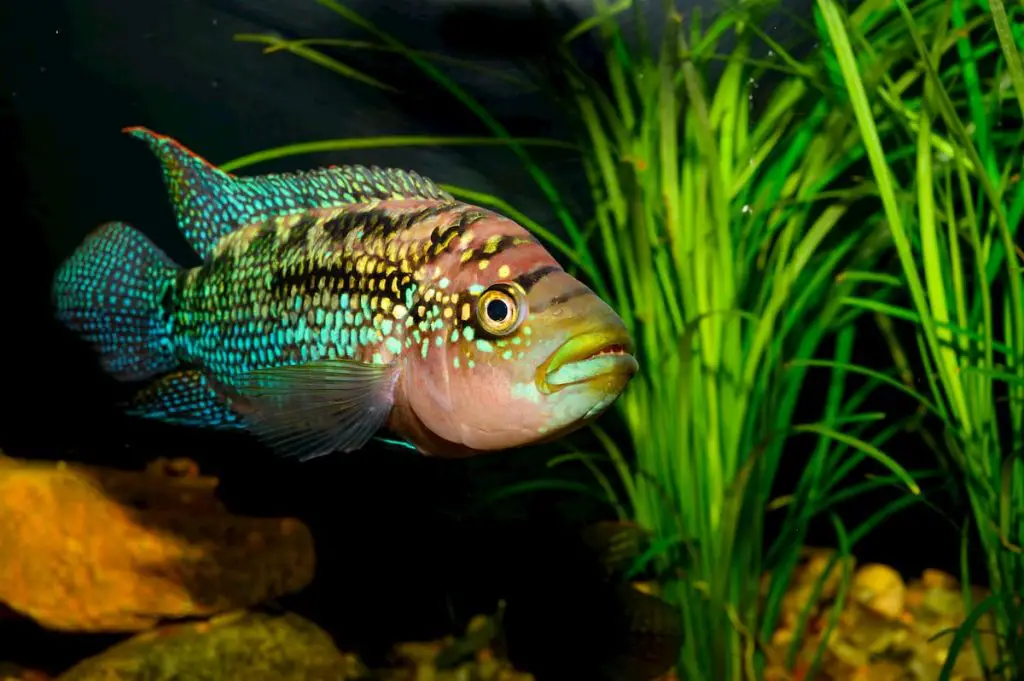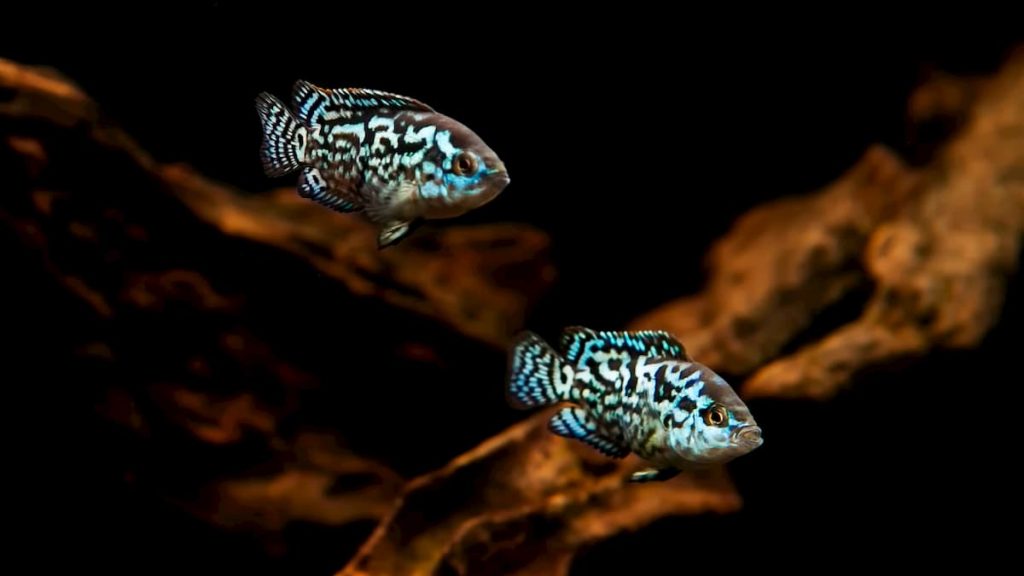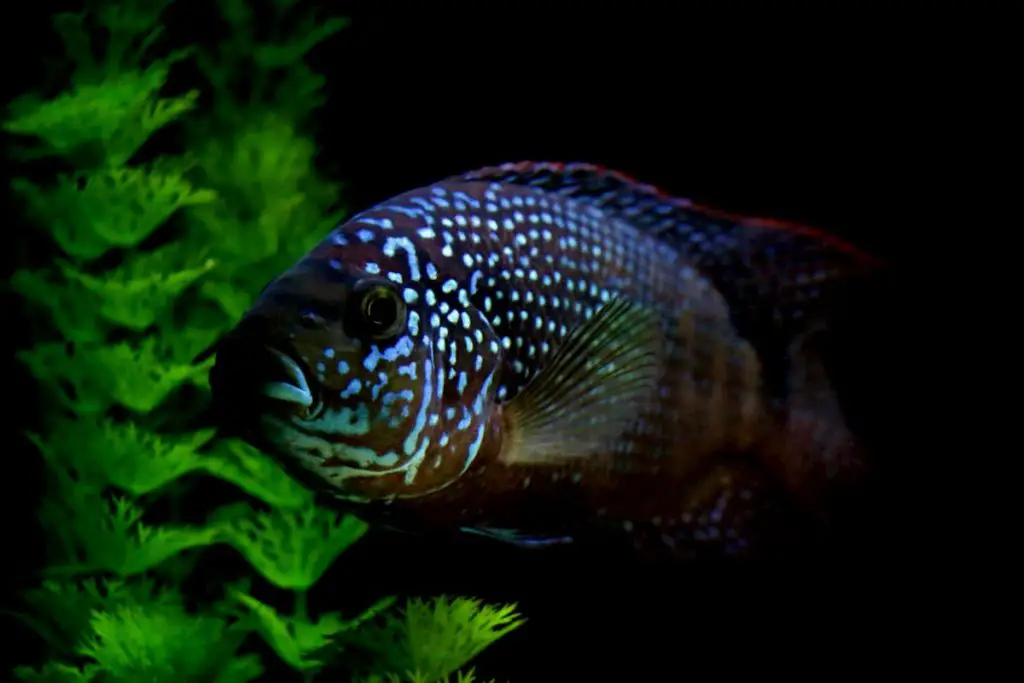Every species of fish is unique and interesting. But there’s something especially unique about this tough, gutsy fish that packs a wallop. The Jack Dempsey Fish, known by this name for its aggressive attitude, is a spunky, active swimmer that will keep you and the family entertained. Just be sure to follow some basic care guidelines to keep them healthy and happy.
Quick Intro to Jack Dempsey Fish
| Family: | Chiclidae |
| Scientific Name: | Rocio Octofasciata |
| Other Names: | N/A |
| Care Level: | Intermediate |
Natural Habitat, Identification, and Where to Buy

The Rocio Octofasciata, more commonly known as the Jack Dempsey is a popular carnivorous cichlid fish species that is native to rivers and freshwater streams in Honduras, Belize, Guatemala, and Mexico. There are also invasive populations of this fish that have been established in Australia, the United States, and parts of Asia. The reason the Jack Dempsey has become an invasive species is that people abandon their pets by throwing them into bodies of water.
This fish’s commonly known name comes from the name of a 1920’s boxer, Jack Dempsey. This fish has strong facial features and aggressive nature, both of which Jack Dempsey was known for.
This species has a very distinct look. It is oval-shaped, longer than they are tall, and has large dorsal fins and anal fins. Their coloration ranges from rosy pinks to dark shades of color, electric blue, and rainbow shades. Their bodies are covered with an iridescent metallic spangle that shimmers when they swim into the light.
This fish is so ethereal that it can be hard to believe it is real. This look is even more pronounced in ones bred in captivity because of how vivid their appearance is. The blues and greens are so bright that it almost looks like an entirely different species of fish.
This fish has an average life span of 8-10 years but have been known to live up to 15 years if taken care of properly with a healthy environment. As this fish grows and becomes bigger, their colors become more pronounced. As this species grows large, it is common to use it as the centerpiece for an aquarium.
The typical pet store will sell this fish from around $5-$10. However, certain rare varieties demand a higher price. If you are looking for a specific color it would be better to call ahead because some shades are difficult to find.
When you’re ready to shop online, you can find them at a number of stores.
Water Conditions for Jack Dempsey Fish
| Water Temperature: | 72 to 78 degrees Fahrenheit |
| Water Flow Rate: | Slow flow rate |
| pH: | 7.0 and 8.0 |
| Water Hardness: | 9–20 dGH |
Tank Setup
| Minimum Tank Size: | 80 gallons |
| Optimal Tank Size: | 100 gallons per pair |
| Optimal Tank Shape: | Rectangular |
| Recommended Filter Type: | HOB filter |
Jack Dempsey cichlids are an aggressive species of fish that needs plenty of territory. So, they need a tank that’s at least 80 gallons. If you will be keeping a pair of this species, a 100-gallon tank will give them enough room with plenty of spaces to hide and swim. It’s better to err on the side of bigger when you keep large fish.
A large aquarium means that having a strong filtration system is important. Fish are constantly putting waste into water and the bigger the fish, the greater the amount of waste. When the waste reaches the bottom of the tank it will begin to break down and this creates ammonia. It only requires a small level of ammonia to become toxic for fish.
A filtration system has beneficial bacteria that help with the ammonia. Certain kinds of bacteria can eat the ammonia and turn it into nitrite. While nitrite is another toxic byproduct, another species of bacteria eats it and produces nitrate. While high nitrate levels can be unsafe for your fish, unless there is something unusual going on the levels can be allowed to build up between water changes. This process is called the aquarium nitrogen cycle.
Another important consideration when choosing your filtration system is the need for it to be strong enough to filter the whole tank. Enough water needs to be pumped through the tank so that the water is moved around and the waste can be brought into contact with bacteria.
The more fish you have and the larger the fish, the greater the waste will be. Not only do you need to be concerned about the waste produced by the fish but any uneaten food. There is no such thing as over filtering water so don’t be afraid to purchase a strong enough filter guaranteed to clean the tank and keep your fish healthy, happy, and swimming for years to come.
Creating the Landscape
When putting your tank together, a goal should be to have the lighting mimic the natural appearance of deep water. Fluorescent lighting is the most popular lighting used for aquariums however this light will only highlight plastic plants, ornaments, and substrate but the natural color of the fish themselves gets lost. Another downside to using fluorescent light bulbs is that they will dim over time and need to be replaced every few months to keep a consistent quality of light.
LED lights have become more popular due to offering several advantages over fluorescent lights. LED lights consume less energy and can last for years while helping to give your tank a natural look. To offset the strength of the light, you can provide your fish with shade by adding something like a hornwort which is a floating plant.
When deciding on the layout of your tank it’s important to remember that Jack Dempsey likes to dig into substrate. They have been known to dig out space and build mounds of gravel. Depending on the temperate of your fish, they may decide to uproot and rip apart your plants. If you are determined to have plants in the tank they will ignore floating plants.
| Best Plants: Hornwort, Water Sprite, Pennywort, Frogbit or Water lettuceBest Lighting: |

Physiological Considerations for Jack Dempsey Fish
| Size: | up to 12 inches |
| Lifespan: | 10-15 years |
| Temperament: | Aggressive |
| Preferred Tank Region: | Bottom |
| Scale Thickness: | Jack Dempsey fish have normally scale thickness. |
| Gill Considerations: | This species has no unique health concerns with its gills. |
| Swimbladder Considerations: | There are no unique considerations for its swim bladder. |
| Fin Shape Considerations: | This fish’s dorsal and anus fins are known to be long and pointed. |
The color of this species varies from fish to fish and their colors change as they age. Over the years the fish will darken in color. Their color is also known to change temporarily for various reasons, pale when they are stressed and dark during mating seasons.
The reason this fish is so well known is because of the range of colors they can be found in. While there are many colors the most popular ones are blue, gold and pink.
Their fins can help tell the gender apart, males have long dorsal and anal fins with pointed tips and females have shorter fins.
This fish’s temperament is notoriously aggressive. Due to this temperament, the fish is not recommended for newbie aquarists. If the fish is not cared for properly then the fish is known to become even more aggressive and attack fish it normally would not.
Society
Due to having such an aggressive nature, Jack Dempsey fish aren’t the first choice for most community tanks. This fish is already territorial but increases as they age. With their size and aggression, it is easy for them to harass, damage, and even kill most fish used in aquariums. Some fish keepers are put off by how aggressive this fish species is. For those not used to dealing with a fish that is known to kill other smaller fish, inexperienced fish keepers may struggle to properly care for this fish.
This is a fish that is not shy about staking out its territory and prefers to have driftwood or a cave so that they have a place to hide if they sense danger. Whenever they retreat to their area they will attack and drive away any fish that tries to get near them. Part of the reason this fish got its name is because of being as aggressive as boxer Jack Dempsey.
It is possible to keep a mating pair together in a tank, however, don’t be surprised if they will attack each other on occasion. However, DO NOT put any other fish along with the mating pair. If the breeding pair see another fish they will attack to kill.
Another thing to keep in mind is that two sexual males cannot be kept together. They will find each other and fight until one or both of them dead.
Any fish that is small enough to fit in a Dempsey’s mouth will end up being a meal and/or be attacked.
If you want a community tank containing Jack Dempseys, you’ll need a minimum tank size of 150 gallons to give your fish room. Ideally, go with a bigger tank. Keep in mind that if the Dempsey fish feels crowded it will start killing other fish.
There are several species that will work well as tank mates with Jack Dempseys:
- Green Terrors
- Firemouth Cichlids
- Angelfish
- Oscar Fish
- Silver Dollars
- Clown Loaches
- Mbuna Cichlids
- Blue Acara
- Severums
- Convict Cichlids
- Plecostomus
- Birchir
Gender, Breeding, and Reproductive Considerations
For Jack Dempseys to mate the tank needs to have exact conditions. The water needs to be fresh. The water temperature should be at 84°F. The larger the male is the greater the chance of the female responding to him.
It is easy to see when a pair of Jack Dempseys are preparing to mate because their colors will begin to darken.
Males are even more aggressive during their spawning season. If the female is not prepared to mate, the male may attack and kill her, so it’s important to keep an eye on behavior to avoid this.
After they have mated, up to 500 eggs may be produced. The eggs get attached to a flat surface in the tank. This could be substrate, decorations, or even the walls of the fish tank. It will take about three days for the fish to hatch.
The parents will dig holes in the substrate for the fry to be safe until they can swim. Both parents share guard duty and will fiercely protect their children. While the fry is in the holes, the parents will crush up food and release it so that they will be able to eat.
Nutritional Needs

Jack Dempseys eat mostly meat for their diet. Their carnivore focused diet in the wild consists mostly of live foods. While hunting, the fish has no problem catching and eating a variety of insects, crustaceans, worms, and small fish. This species is not known for being a picky eater.
The staple of Dempsey’s house in aquariums should be a high-quality pellet. The advantage of this processed dry food is that they are easy to find and custom-designed for Jack Dempsey’s to eat. Good protein-heavy pellets like Fluval Bug Bites Cichlid and Cichlid Pellets are good choices.
While pellets offer much-needed nutrition, your fish will need more to stay healthy and it is good to offer your fish a variety of live and frozen foods. Commonly used foods include black worms, grasshoppers, fruit flies, blood worms, crickets, brine shrimp, and daphnia. One thing that this species will rarely eat is plants.
The age of a Jack Dempseys influences how often they should be fed. Juveniles should be fed 2-3 small meals each day and adults should be fed larger meals 1-2 times a day. It is important to pay attention to how much your fish eat and make sure you do not overfeed them. After adding food to the tank, the fish needs around two minutes to eat. Once the fish have finished eating their food it is important to immediately remove any food they did not eat.
Recommended foods for feeding your Jack Dempseys:
- Cichlid Pellets
- Fluval Bug Bites Cichlid
- Bloodworms
- Brine shrimp
- Crickets
- Grasshoppers
- Fruit flies
| Best Sustenance Food Type: | Specialized high protein Cichlid pellets |
| Additional Food For Optimal Health: | High protein snacks like bloodworms, brine shrimp, and crickets, several times a week, along with the pellets. |
| Special Foods and Considerations for Best Color and Growth: | A solid blend of all of the above. |
| When and How Often to Feed Fish Based on Life Cycle: | Only as much food as they’ll in a two-minute window, 1-2 times daily. Feed juveniles 2-3 times daily. Schedule their meals at times that will suit your schedule. |
Common Diseases and How to Avoid and Treat Them
Jack Dempseys are known for being a healthy and hardy species of fish, when they are properly taken care of they can live upwards of eight to ten years. Despite being such naturally healthy fish, they are susceptible to some diseases which affect freshwater fish. Most of the illnesses that affect this breed can be avoided by simple measure such as maintaining strict water quality and make sure your fish has a proper diet.
Almost all of the diseases fish can catch can come from being around infected fish. Before introducing a new fish to your tank put your new fish into quarantine in order to make sure that it is free from any infectious disease that can spread.
Head and Lateral Line Erosion (HLLE) is where a hole will appear in the fish’s head. This condition is caused by a bacterium known as Hexamita. This disease can be made worst by stress, a weak immune system, improper diet or the fish living in poor water conditions, a lack of proper nutrients including calcium, phosphorus, Vitamin C and Vitamin D. If left untreated the holes in the head will grow and the fish will die. Treatment involves a combination of using vitamin supplements, antibiotics, and making sure you fish is eating properly balanced meals.
Skin flukes are parasites that attach themselves to the skin and gills of fish. As the flukes begin to grow and spread, they cause lesions to appear on the fish body and cause the fish to produce large amounts of mucus. The fish loses weight, moves around restlessly and will rub against rocks and other hard surface in order to try and relieve their pain. There are several types of medications like formalin and anthelmintics that have been found to be effective at treating this disease.
Freshwater Ich is one of the most common diseases that affects freshwater fish and cichlids. A fish affected by the parasite that causes this disease will develop white spots on the body, lose weight, have trouble breathing and have trouble writing. An effective cure for this has found to be a combination of heat treatment by raising the water of your tank to 86° Fahrenheit and use of malachite green and formalin.
| Best Antibiotics: | Formalin, praziquanteland, some organophosphates, malachite green |
| Treatments to Avoid: | Nothing of note. |
| Food Recommendations When Sick: | Feed extra protein content meals. Provide supplementation of Vitamins C, D, and phosphorous. |
| Hospital Tank or Isolation Withing the Community Tank: | Separate from other fish, especially any other aggressive fish. |

5 Facts About Jack Dempsey Fish
- This species has become an invasive species in Thailand, Russia, and the United States
- The bright blue Jack Dempsey is the result of a genetic mutation.
- Before its current name, the first was known as Cichlasoma, Archocentrus, and Heros.
- This species of fish is known for forming nuclear families.
- The namesake of the fish was a famous boxer. He is known for having won the title of Heavyweight Boxing Champion of the World in 1919. When researchers first started keeping this species they noticed that they were very aggressive and gave them the nickname.

